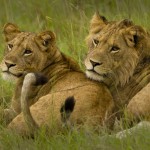The Basoga are the eastern neighbors of the Baganda.They occupy the region between Lake Victoria and Lake Kioga the present districts of Kamuli, Jinja and Iganga.
Origins
Due to the continuous movements and intermingling of the people within the Basoga region, the history of Basoga is complex. It can be asserted however that the earliest inhabitants of Busoga belonged to the same Bantu group comprising the Batooro and Baganda. Their origin can therefore be traced like other Bantu groups to the Katanga region of Central Africa.
Tradition holds that the earliest in habitants were the langi; the Iteso and Bagishu.They were later engulfed by migrants from Buganda.
The earliest settlers in Busoga are said to have occupied Lake-shore areas of modern Bukoli .Nyanyumba’s Banyankole are believed to have been among these earliest inhabitants. These early settlements took place far back in the 14th century. They were later joined by other people from Mt. Elgon region. These people are said to have been led by Kintu and are said to have settled in Bugabula and Bulamogi. They were later joined by others from Budama and some from Kigulu in Kenya.
Legend
There are three legends regarding the origins of the Basoga. One of them talks of the famous hunter, Mukuma, who came from the East side of Mt Elgon and crossed via present Bugishu and Budama. He is said to have been accompanied by his wife, various followers and two dogs.
Mukuma had eight sons during his stay in Busoga. These sons were subsequently appointed rulers over certain areas. Mukuma preceded to Bunyoro were he set up a Kingdom. He died of smallpox and that id why the relatives of Mukuma in Busoga ado not look at a patient with small pox. It is also customarily that no member of the Ngobi clan passes another one with smallpox without touching him.
The second legend insists that Mukuma did not come to Busoga at all that Mukuma only sent his sons to rule Busoga because there were no capable rulers in Busoga.
The third legend talks of Kintu having been the man called Mukama and it was this same Kintu who came to Busoga from the east of Mt Elgon. This legend asserts that Kintu left his sons in Busoga and continued t Buganda. He is said to have returned to Busoga and lived in a place called Buswikira which is at Igombe, Bunya. He died and was buried there. Afterwards, his tomb became a rock which is worshiped even today by some Basoga.
Originally, the Basoga were a disunited people. They could not unite even in the face of a common enemy. This explains why they were incessantly prone to foreign influence first from Bunyoro and later form Buganda.
Language
Lusoga language closely approximates to Luganda, especially that spoken by the Ssese islanders. There exist many Lusoga dialects. However, Buganda influence over Busoga was so much that Luganda tends t be used as alingua Franca in Busoga more than Lusoga itself. Within Busoga, there are so many dialects of the Lusoga language that is difficult to reach agreement on the correct way to spell or pronounce certain words. For instance, in the north of Busoga, there is a distinct H but people from southern Busoga do not accept this H as being appropriate to the Lusoga Language.
Luo Influences
The Basoga were also under the influence of the Luo rulers of Bunyoro. As a result, the Basoga followed some of the Luo customs. For example, at puberty they used to extract the sixth teeth in the lower jaw as initiation adulthood like the Alur of West Nile and the Joluo pf western Kenya. Even some of their ceremonies especially those regarding death, tended to resemble those of the Luo.
Land ownership and the economy
In Busoga, each clan had land and the Mutaka (clan head) was responsible for the clan’s land. This land could not pass ownership from one clan to another r nor could a member was granted land by the clan head be deprived of it. There was plenty of land inspite the population. Any member could get land by simply asking the clan head for it.
A non clan member could be allowed t cultivate land but only as a Mugiha (tenant).The land could be taken from him could it be required by any member of the clan to which it belonged. They were settled agriculturalists and they were quite rich in food and cattle.
Death and burial rites
A chief
Whenever an important chief was sick, very few people were allowed to come near him. His death was first kept a secret until all his wives, cattle, hoes, ivory, and male slaves had been secured.Thereafter, the official announcement was made early in the morning by a Mujwa (funeral officer). It was then that the chief’s wives, herdsmen, and people wept and kissed the corpse. No work of any kind could be done, not even visiting or cooking could be done. If there happened to be any other dead people, their burials had to wait until the chief’s funeral rites were completed.
It was taboo any cock to crow during the period. No one shaved until the rites were over. The older wives of the chief were gathered and kept in the death hut for seven days supporting the body of the dead chief across their feet. For these days, they were not supposed to touch food of any kind.
Burial
The chief was buried in the hut of his first wife. He was buried with some objects his body facing towards their supposed direction of origin. Most Basoga bury their dead facing northward because they believe that they came from Bunyoro. The chief’s grave was deep indeed about ten meters.
Before burial, the corpse was washed all over by the wives. A new barkcloth was hung across the doorway of the hut. The corpse was smeared with butter and a large colored bead was tied around the neck. In Bugabula, a piece of flayed cowhide was taken from a cow sacrificed to the dead and laid upon the forehead of the corpse. Other presents like beads, wires or bracelets were also tied on the arms and legs of the corpse. The body was then carried to the burial hut by the Bwagwa and put in the grave but no earth was put in yet. A bullock was tied to the doorway of the hut and dedicated to the dead chief. The ceremony was extended to inaugurate an heir.
Burial of the head of the family.
All children kissed the corpse and wailed loudly. No cooking was allowed for one day. His could be dug in his own hut, garden or courtyard. The heir could be appointed at the time of burial. The other rites were not reopened t add fresh barkcloths like the chief’s. They could only sprinkle beer and blood over the grave.
Burial of a childless man
A young man was treated like an old man. If he was unmarried, a widower, or married but without children, a broom was placed on the grave and he was ordered not to come back in the following words. “Go straight away and never return to earth, you childless one”. His name was despised in the society and care was taken not to give it to another person for fear that he also might become childless.
Burial of a married woman
The husband would wail and kiss the corpse and so would some relatives. She was buried in the banana plantations according to the customs of the husband.Often; she was made to lie on her left. She was informed upon being buried that none of those present had caused her death and was implored not to comeback for revenge.
Should she have possessed property, her spirit was placated by the offer of a goat or a bullock before the heir took over the property. Customs demanded that the dead woman’s relatives should bring for ward unmarried girl and give her to the dead woman’s husband. This girl became the heiress and took over the functions and property of the dead woman.
If the deceased woman had daughters who were married, their husbands had t redeem them from the deaths spirits with a goat. There was another special ceremony for a dead woman who left married sons. Each of the wives of her sons cooked food and took it to the burial where they would find their husband awaiting them.
The women dressed themselves up like men and went to the banana plantations. They would sit down in a manner men did when they went to arrange the bride wealth or to redeem their wives from funeral rites. Their husbands would dress up like women and come to greet their wives. Then they would do all they could to make their wives laugh. If any of the women laughed, she was deemed unfit; the food she brought was considered unfit for eating; and her marriage was cancelled.
In case of a childless woman, the speaker said,” Never come back for you left nothing behind.” A broom was then placed on the grave and her name was allowed to die out of society. Un married girls were buried on almost the same way as women, only no heiress was necessary.
Religion
The Basoga believed in the existence of a spirit world. They called the Supreme Being lubaale. Human agents worked as messengers of Lubaale, or the ancestors, or other minor gods. To the Basoga, the spirit world, places of worship, animated objects and fetishes had power to do good or evil to the living. The Basoga call magicians, fetishmen and spirit mediums Bachwezi.
The Basoga believed in the existence of gods and sub-gods. Below lubaale, there were mukama the creator of all things; Jingo, the public god who attended to the general needs of the people; Nawandyo; and Bilungo the god of plagues. Semanda, Gasani and Kitaka were other gods the Basoga believed in.
Political set-up
There were no paramount chief over the whole of Busoga.The Basoga were organized into principalities or chiefdoms under the sovereignty of Bunyoro and later Buganda. In early times, the death of a chief was first reported to the Omukama of Bunyoro who would send the funeral barkcloth and all the necessary requirements for the burial rites. On several occasions, he used t appoint the heir or send back the son of the deceased chief if the son happened, as usually the case, to be at the Mukama’s court in Bunyoro.
During the time of the Luo migration, Luo sub-dynasties were established in Busoga. Among these sub dynasties (at lest six in all), Bukoli and Bugwere were founded about the same time as the Babiito dynasty of Bunyoro at the beginning of the 16th century. By the turnoff the 19th century, there were fifteen virtually independent principalities. Infact, the southern principalities are said to have been ruled by dynasties whose origins could be traced to the east and Lake Victoria islands. During the 19th century, Buganda influence very greatly increased over the southern Busoga principalities. The northern principalities still had a connection with Bunyoro and indeed their language contained Runyoro words.
In 1906, the British protectorate accomplished an administrative amalgamation of the multifarious Kingdoms of pre-colonial Busoga into a single integrated structure. Representatives from the small pre-colonial kingdoms consisted of the Busoga Lukiiko. In the same year Semei Kakungulu was appointed President of the Lukiiko, his reign ended with his resignation in 1913. This led to the collapse of the monstrous political structure and the abolition of the office of “president of the Lukiiko of Busoga”. Later, there arouse demands within the Basoga for the revival of the office. In 1919 the Isembantu Kyabaziga office was established as an alternative to it. And Ezekeeri Wako was appointed the first Isebantu Kyabazinga.

 Posted in
Posted in 

